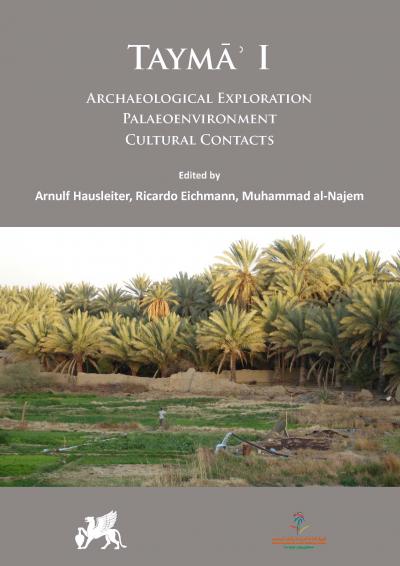Taymāʾ I: Archaeological Exploration, Palaeoenvironment, Cultural Contacts
https://doi.org/10.34780/j222-4ma2
Synopsis
The present volume is the first of the publication series of the Saudi-German archaeological project and focuses on three fundamental aspects of research at Taymāʾ: the current archaeological exploration of the oasis is contextualised with previous and ongoing research within the region, while at the same time offering a first overview of the settlement history of the site, which may have started as early as more than 6000 years ago. New information on the palaeoenvironment has been provided by multiproxy-analysis of sediments from a palaeolake immediately north of the settlement. The results indicate an Early Holocene humid period in the region that is shorter than the so-called African Humid Period. The abrupt aridification at around 8 ka BP, known from other regions in the Near East, is also attested in north-western Arabia. The reconstruction of the past vegetation of the site and its surroundings demonstrates that oasis cultivation at Taymāʾ started during the 5th millennium BCE with grapes and figs, rather than with the date palm. According to hydrological investigations on water resources, groundwater aquifers provided the main source of local water supply. These were exploited through wells, some of which have been identified in the area of the ancient oasis. Finally, since the time of early travellers to Northwest Arabia evidence of cultural contacts has been observed in the records from the site, which had been occupied by the last Babylonian king, Nabonidus (556–539 BCE) for ten years. A historical-archaeological essay on Egypt and Arabia as well as a study on the ambiguous relationship between Assyria and Arabia – characterised by conflict and commerce – shed new light on the foreign relations of ancient Taymāʾ.
Keywords:
Tayma, Taima, Taimah, Taymah, Teima, Tejma, تيماءChapters
-
Foreword - Introduction - Preface
-
The Archaeological Exploration of the Oasis of Taymāʾ
-
Palaeoenvironmental Changes at Taymāʾ as Inferred from Sabkha Infill
-
Taymāʾ Oasis (Saudi Arabia) and its Surroundings – a First Synthesis of the Flora, Vegetation, Natural Resources, and Floral History
-
Early to Middle Holocene Vegetational Development, Climatic Conditions and Oasis Cultivation in Taymāʾ: First Results from Pollen Spectra out of a Sabkha
-
The Water Management of Taymāʾ and Other Ancient Oasis Settlements in the North-Western Arabian Peninsula – a Synthesis
-
Ägypten und Arabien
-
Untersuchungen zu den ‘arabischen’ Toponymen und zur Rezeption der ‘Araber’ in den historischen Quellen der Assyrer




